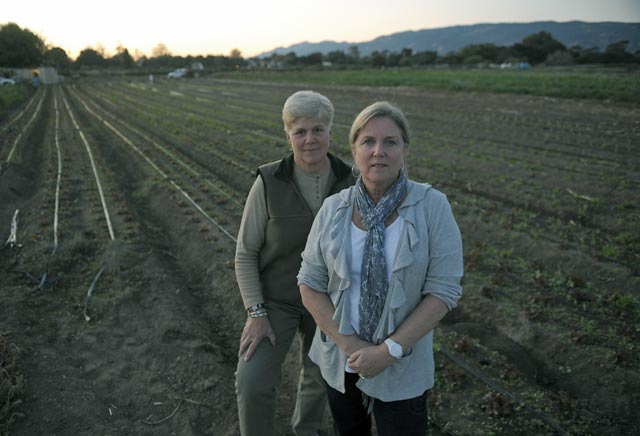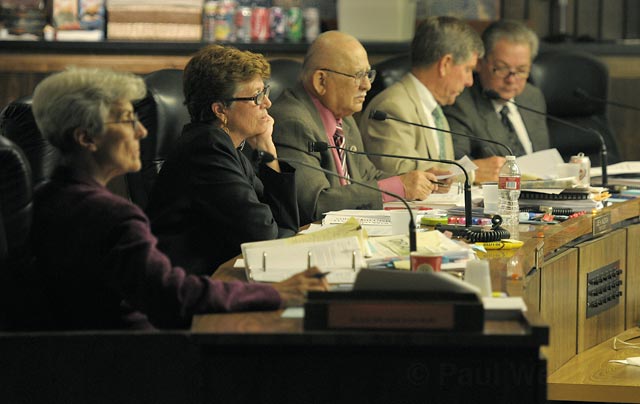Fight for Future of Noleta Farmland
Residents, Developers, and County Ponder Next 20 Years of Eastern Goleta Valley

It’s a sunny Monday afternoon in the Eastern Goleta Valley, and farm vehicles are skirting back and forth across San Marcos Road, just a few blocks off bustling Hollister Avenue and a stone’s throw from the backyards of tract homes. It’s a daily scene for many neighborhoods in this semi-rural patch of unincorporated Santa Barbara County, a place often referred to as Noleta, where about 38,000 people live in subdivisions, condo complexes, and apartment units amid nearly 500 acres of agricultural land. But as the County Planning Commission moves forward next Wednesday, November 16, with what will likely be its final vote on a 20-year community plan, some fear that the Eastern Goleta Valley may never be the same.
“We’re well-meaning, hard-working, reasonable people, but we feel like the county is rolling over us,” explained Barb Kloos this week while sitting in the backyard of a friend’s home in Sungate Ranch, across the street from the San Marcos Growers property. “We’re not saying that you can’t change it at all. But what’s being proposed and talked about is not in line with the character of change that we’d like to see.”
Specifically, Kloos — a marriage and family therapist who started the Eastern Goleta Valley Coalition and its Web site saveourvalley.net — believes that the county is open to turning too much ag land into high-density residential zones, that the remaining farms will be allowed to do way more than just grow plants, and that fancy smart-growth ideas meant for urban cities are being “plopped” into her suburban neighborhood. “It’s not what any of us want. They are going against the will of the people,” said Kloos. “We don’t feel it’s a community plan anymore. We feel it’s a developer-county plan.”

Middle of a Long Road
Calling the effort to envision Noleta’s next 20 years a planning marathon doesn’t do the protracted process justice. When the Planning Commission takes it up again next week, it will be the 45th time since 2008 that a public meeting has been held on the matter, and final results — following environmental review and Board of Supervisors’ approval — aren’t even expected until 2014. Most of the heavy lifting was done by the Goleta Valley Planning Advisory Committee (GVPAC), which held 38 hearings and, earlier this year, produced a comprehensive draft plan that covers everything from public safety to archaeology.
Although not everyone liked that plan — namely the trio of women behind the Coalition for Sensible Planning, as well as the heels-dug-in folks who want to preserve ag land at all costs — the GVPAC draft was a well-considered balance between keeping the feel of Noleta while allowing for a bit more development on a small percentage of existing farmland. It proposed interesting mixed-use urbanizations for two commercial cores (the “Valley Junction” along Turnpike Rd. and “Bowtie,” where State St. turns into Hollister Ave.) and also suggested giving farmers some other options to keep their land economically viable, such as packinghouses and bed-and-breakfast inns.
But in August, after the three years of GVPAC work had concluded, the state told the county that the plan would not satisfy high-density housing mandates. Such a determination would be disastrous, said Jeff Hunt, the county’s director of Long Range Planning, because it would open the county to lawsuits, one of which has already been threatened by California Rural Legal Assistance. “Our defense against legal attacks would be very much weakened,” said Hunt, who worries that a random judge could be put in charge of development decisions. “We are taking the threats seriously.”
Suddenly, the Planning Commission and county staff began scrambling in order to jam more high-density potential into Noleta, which some argue already has more density than anywhere in the unincorporated county. During a September meeting, the commissioners and planners discussed a number of new rezoning possibilities and tossed in some lot-line adjustments in the Hope Ranch Annex area that they hoped might solve the problem. That threw residents — many of whom were just hearing about the plan for the first time — into a coalition-founding, letter-writing, and public-commenting frenzy; conspiracy theories about county staffers secretly trying to insert high-density housing began sounding rational. Even GVPAC members have started to freak out, wondering why their three years of work were being tossed aside.
Though he believes that county staffers are just “trying to do their jobs,” Kenan Ezal, vice chair of GVPAC, feels that the county is acting a bit too conservatively about the mandate threat, explaining that state law simply says that densities “should” be considered. “I find it very difficult to believe that the state could find us in noncompliance,” said Ezal. “The GVPAC did consider certain things, and we rejected certain things.” Although he’s not quite as “disillusioned” as some of the other committee members, Ezal was discouraged when the county wouldn’t let the GVPAC take another look at the plan with the new density information in mind. “I’m used to a certain amount of scientific process,” said Ezal, an engineer at Toyon Research by day, “and this is not that. It seems a little ad hoc.”
Some of the Planning Commission’s more novel density ideas have already been scaled back, said Hunt, explaining that the current plan is to study rezoning for 23 out of 478 total acres of ag land (only six more than the GVPAC’s proposal) and that they’ve only bumped up total new units from the GVPAC’s suggestion of 540 to 690. “And that’s over a 20-year-period,” said Hunt. “I don’t see that the Planning Commission has taken a radical departure from what the GVPAC recommended. … It’s an inch-thick document. If this is the only place where there’s disagreement, then I think we’re doing a good job.”
The Man Who Wouldn’t Take No
A perennial player in the Eastern Goleta Valley land wars is Michael Towbes, the octogenarian developer who’s aligned with “workforce housing” advocates in his quest to turn the San Marcos Growers property from nurseries and row crops into suburbia. Due to a big battle almost a decade ago when Towbes proposed 1,000 homes, the property became a symbol of saving urban farmland, and no one has yet dared to suggest it be rezoned for housing, lest they feel the full wrath of the community. But that hasn’t stopped Towbes from repeatedly trying to get it on the table. It was his letter to the state — which critics claims is full of mistruths — that caught the attention of the housing-density police.
“It doesn’t seem fair that these neighbors are living on property that used to be agriculture that’s been converted to residential, and they won’t even allow us to study what the impacts would be of such proposed conversions,” said Zimmerman
Towbes’s representative Craig Zimmerman argues that the property should be part of the density study so that all the facts can be considered in a transparent manner. “It doesn’t seem fair that these neighbors are living on property that used to be agriculture that’s been converted to residential, and they won’t even allow us to study what the impacts would be of such proposed conversions,” said Zimmerman, explaining that the property owners purchased the property when it was zoned residential. “This is not a land grab. Their intention all along was to build housing.”
That’s the kind of talk that’s making Kloos, GVPAC members, and pretty much most Noletans fear that the Towbes machine will not stop until the San Marcos property is growing townhomes. Said Kloos, “He’s a man who won’t take no for an answer.”
Decision Day
On Wednesday, November 16, as part of its seventh meeting on the topic, the Planning Commission is scheduled to vote on the entire plan. But it will be the first time they hear details about secondary uses of ag land, which is another sticking point for Kloos and the Eastern Goleta Valley Coalition, who believe that the whole proposal for allowing processing centers and bed-and-breakfasts is way too vague. “It’s too loose and too undefined,” said Kloos, who fears that the “defacto rezoning” could trigger changes throughout the county. “Once you make that conversion here, what’s to stop someone in Summerland or Carpinteria from asking for the same thing?”
Before that meeting, Kloos is scheduled to meet with Glenn Russell, director of County Planning, as well as 2nd District Supervisor Janet Wolf. She hopes that those face-to-face interactions will help counter the anxiety and sense of “mistrust” that she and others have of this government process. After all, her group is now “grudgingly agreeing” to the study of 20 agricultural acres as high-density residential because the Planning Commission has done a good job of spreading it around. But at the end of the day, she still wonders how much this process is about the community and its quality of life because so much of it revolves around development. Said Kloos, “We are not even getting a new park.”



